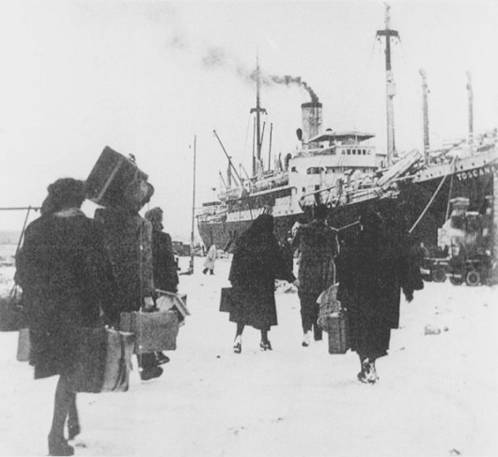


The Second World War is the conflict they say we’ll never forget. Manifold atrocities, subjugations, sufferings and displacements are its legacy, the very exemplary of a brutality we are warned not to repeat, but even as we dutifully recall the war’s effects there remain episodes we speak little of today. Among them are the events that took place between Italy and the former Yugoslavia.
The tension between the two central European giants, that fomented tragedy for one population of Italians in particular, is rather complex and merits some explaining. Sizeable border areas, Istria, Dalmatia, and the Quarnero islands, now part of Croatia, and the cities of Trieste and Gorizia, disputed between Italy and Yugoslavia and at present Italian, contained both Slavs and ethnic Italians in the 1940’s. Italians who had established themselves in these parts for centuries refer to themselves as Giulianians (“Giuliani”), from the influence of the northeastern Venezia-Giulia region. The Association of Giulianians in the World (“Associazione Giuliani nel Mondo”, or AGM) [2] is dedicated to commemorating the Italian presence in those areas and their subsequent, rather grisly diminishment following the Second World War.
Succinctly put, the Yugoslavian partisans of Josip Tito’s Communist government, in 1943 and in the immediate aftermath of the war, engaged in a politically and ethnically motivated campaign to rid Italians from Dalmatia and Istria. Open hostility broke out against Italians, seen as belonging to the nearby Fascist regime, and anywhere between 10, 000 and 15, 000 of them (numbers are contentious) were killed. Civilians, regardless of age or gender, were gunned down and thrown into 
The AGM inaugurated its traveling exhibit, “Into the New Millennium with Our Roots” (“Con le nostre radici nel nuovo Millennio”), along with a documentary by Chiara Barbo and Andrea Magnani, “Triestine Girls” (“Le ragazze di Trieste”), at the Italian Consulate in New York. The exhibit, which the AGM is planning to permanently install in its headquarters in Trieste, consisted of several large panels outlining the history of the Giulianian diaspora. The black and white pictures, along with photocopied letters and historical documents, had both a deeply intimate feeling to them—many were retrieved from families—and a touch of the didactic. Indeed, the consolidation of this material, affecting because in part it resembles the personal effects lost after a shipwreck, brings to the public eye, for the first time, what AGM’s President Dario Locchi called “a lost page in history”. Locchi went on to explain that only 22 percent of Italians know anything about this piece of history, and among them, only 57 percent know of the consequent Giulianian flight.
The exhibit’s mission is to inform as large an audience as possible (it has been carried across continents), breaking the silence surrounding the suffering of a people and their forced exodus—an Italian emigration, Locchi underlined, vastly different from the Ellis Island variety. We come to know through the display, somewhat surprisingly, that some of our most beloved Italians and Italian Americans were of Giulianian descent, including screen siren Alida Valli, Mayor Fiorello LaGuardia, influential art-dealer Leo Castelli and racecar driver Mario Andretti. One such notable was present at the event itself, renowned celebrity chef Lidia Matticchio Bastianich [5], who provided the catering for the presentation and for whom the issue of exodus is profoundly, personally significant.
Talò touched on what may be one of the most interesting aspects of the Giulianian population. He had opened his moving, at times apologetic, speech by saying that the exhibit brought an Italian sentiment that was more deeply felt because it was mired in suffering. Throughout, speakers from the Association reminded the audience, a gathering of Italians and Italian-Giulianians, that they had endeavored to never lose their Italian identity, and listening to them, one had the impression that their purpose was not just to reclaim a place in history but to assert their very Italianness.
The screening of “Triestine Girls” mitigated some of the sense of desperate migration. The documentary traces the fate of Triestine women who left Italy for love, marrying American soldiers stationed in their city during WW II and then moving to the U.S. to build entirely different lives. As Chiara Barbo pointed out, the women protagonists, now well into old age, recall their experience of cultural transition with humor and what she called, “a typically Triestian irony”. One sprightly woman spoke of wonderment at skyscrapers, and another of the difficulty of buying a pack of cigarettes when a store clerk couldn’t understand her thick accent—a patchwork of anecdotes that contributed to the work’s buoyant feeling.
i-Italy had the chance to speak about Barbo’s documentary, and more, with Lidia Bastianich. Bastianich has had a successful cooking show on PBS, “Lidia’s Italy”, for many years and owns a number of restaurants in the U.S. in partnership with her son, Joseph. She contributed her talents to the exhibit with a feast of trypically Triestan specialties.
Her family hails from Pola, Istria, and moved to New York in 1958, when Bastianich was 11 years old.
What did you think of the documentary?
What is some of your personal history of emigration?
What do you feel about this “lost page in history”, about what this exhibit will achieve?
Do you pass this story on to your children?
Dario Locchi would echo this same sentiment when he said “There can be no future without memory of the past”. This “proud people, who paid the price of a lost war” can take solace in their Association’s efforts. Because there can truly be no future if grief isn’t taken out of the shadows and brought into the light.
Source URL: http://ftp.iitaly.org/magazine/focus/life-people/article/painful-piece-italian-history-overlooked
Links
[1] http://ftp.iitaly.org/files/istrian-exodus1214327442jpg
[2] http://www.giulianinelmondo.com/
[3] http://youtube.com/watch?v=L0Ks8I6Wu98
[4] http://en.wikipedia.org/wiki/Istrian_exodus
[5] http://www.lidiasitaly.com/
[6] http://www.theslovenian.com/articles/2008/thomassen.pdf